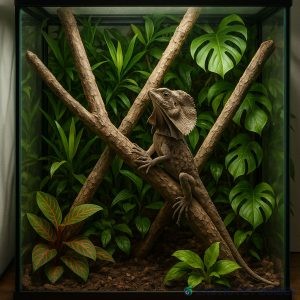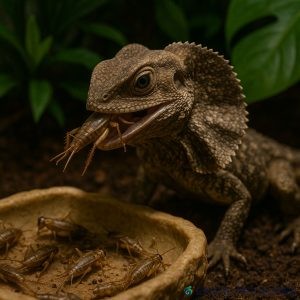Frilled Dragons (Chlamydosaurus kingii) are among the most striking lizards in the reptile world. Their iconic frill, which expands dramatically when they feel threatened, makes them an unforgettable sight. Native to northern Australia and parts of Papua New Guinea, these arboreal reptiles can be fascinating pets—but they’re not for everyone. This guide will help you determine whether a Frilled Dragon is the right choice for your lifestyle and experience level.

What Makes Frilled Dragons Unique?
Frilled Dragons are best known for their defensive display: when alarmed, they raise a large frill around their neck, open their mouths, and may even run on two legs. While this behavior is mostly for show, it highlights the lizard’s natural instincts and evolutionary adaptations.
They also stand out for their:
- Arboreal nature (they love to climb)
- Diurnal activity (active during the day)
- Curious, alert personalities
Size and Lifespan
- Adult Size: 2–3 feet in length (most of that is tail)
- Lifespan: 10–15 years in captivity with proper care
While they may look intimidating due to their frill and length, they’re generally docile when properly handled from a young age.
Are Frilled Dragons Good for Beginners?
✅ Pros:
- Visually impressive and entertaining
- Usually tolerant of handling
- Active and engaging during the day
⚠️ Cons:
- Require tall enclosures and precise humidity control
- Need UVB lighting and a temperature gradient
- Can be shy or stressed in noisy environments
Frilled Dragons are a better fit for intermediate reptile keepers, though a committed beginner with time and resources can succeed.
Basic Enclosure Requirements
Frilled Dragons need tall, vertical space and a well-regulated environment.
- Minimum enclosure size: 4 ft tall × 3 ft wide × 2 ft deep
- Substrate: Coconut fiber, cypress mulch, or soil blends
- Lighting: Strong UVB bulb + heat basking lamp
- Humidity: 60–70% with daily misting or humidifier
- Decor: Vertical branches, vines, and foliage for climbing
Diet and Feeding
Frilled Dragons are insectivorous, especially as juveniles. Adults can occasionally eat small vertebrates or fruit.
- Staples: Crickets, dubia roaches, silkworms, mealworms
- Occasional: Pinkie mice (adult only), berries, banana, mango
- Supplements: Calcium with D3 (3x per week), multivitamin (1x per week)

Temperament and Handling
While they may look fierce when flaring their frill, Frilled Dragons are generally non-aggressive. Young dragons may be shy, but with slow, calm interactions, they often become quite tolerant of handling.
- Begin handling in short sessions
- Avoid loud noises or sudden movements
- Let them climb onto your hand instead of grabbing
Common Challenges
- Humidity stress: Too low humidity can cause dehydration or shedding issues
- Feeding consistency: Some individuals may become picky or inactive if bored
- Overhandling: Can lead to stress and frill displays
Frilled Dragons are sensitive to environment changes, so stability is key.
Final Verdict: Is a Frilled Dragon Right for You?
If you’re ready to commit to a large enclosure, invest in proper lighting and humidity, and give your dragon some personal space, Frilled Dragons can be one of the most rewarding and visually impressive lizards to keep.
However, if this is your very first reptile, you may want to start with a more forgiving species before working your way up to a Frilly.